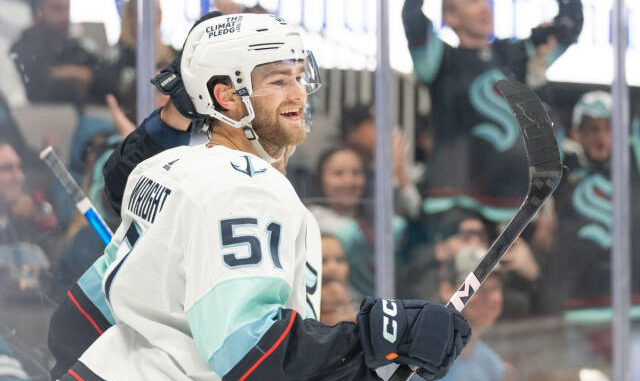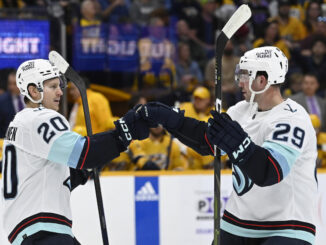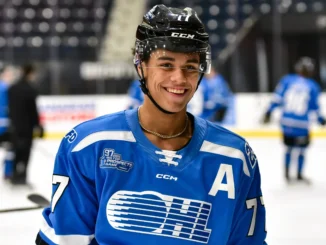
As we enter the sixth week of the 2024-25 NHL season, the Seattle Kraken own a record of 6-8-1 (13 points) after 15 games. The team’s points percentage (PTS%) sits at .433 and ranks in the bottom 10 in the league. The Kraken are on the outskirts of the Western Conference playoff picture and already have ground to make up on the teams in front of them, many of which have games in hand.
While such factors as the Kraken’s overall scoring issues and lack of top-level stars are well-documented, the play of highly-regarded young players like 20-year-old Shane Wright warrants a deeper investigation.
On the surface, Wright appears to have taken a step back to start the campaign. After scoring 22 goals and 47 points in 59 games with the Kraken’s American Hockey League (AHL) affiliate Coachella Valley Firebirds, Wright earned a late-season call-up and tallied four goals and five points in eight games with the Kraken, offering a taste of his tantalizing potential during his first full season as a professional.
Related: Daccord Should Have Permanent Role As Seattle Kraken’s Starting Goalie
It’s understandable, then, that Wright entered his first full NHL season with heightened expectations after getting his wayward development back on track. Yet, through 15 games, the center’s statline reads one goal and one assist, which is quite a letdown from what his play last year might have teased to the fanbase.
Depressed scoring totals aside, has Wright’s performance really taken a step back, or do his underlying numbers under the hood paint a more favorable picture of his professional development? Let’s dive in.
Wright Struggling to Individually Generate Offensive Opportunities
While boxscore statistics such as goals, assists, and points are the be-all and end-all of player analysis in the minds of fans, they often lack crucial context that may explain numbers that may disappoint or underwhelm at first glance.
For example, a player who does not receive much ice time logically has fewer opportunities to rack up points compared to someone who receives greater usage in all situations. Some of that may be due to a legitimate talent disparity (I won’t say Wright is better than Nikita Kucherov or deserves his level of deployment, for example), but it’s also a rational claim regardless.
So, using a player’s individual shot or chance generation per 60 minutes at five-on-five both standardizes rates for players across all tiers of usage and levels the playing field by removing power play minutes, which would skew the outputs. With that in mind, here are Wright’s individual numbers over his first three NHL seasons.
| Statistic (Per-60-Minutes) | 2022-23 | 2023-24 | 2024-25 |
| Shots | 3.7 | 8.1 | 4 |
| Expected Goals | 0.7 | 1.5 | 0.5 |
| Scoring Chances | 5.6 | 10.1 | 4.4 |
| High-Danger Chances | 4.7 | 4.7 | 2.8 |
It should be noted that Wright has only played in 31 NHL games over the past three seasons, so there are guaranteed wild fluctuations across such a small sample size. The third-year forward has seen his individual numbers drop across the board, which, coupled with his individual (10%) and on-ice team shooting percentage (11.3%) hovering around the NHL average, don’t offer much hope for Wright’s luck to change in the immediate future unless he starts generating more chances for himself.
A look at Wright’s most common linemates also suggests that the onus is on the center to become more actively involved in driving the attack. This season has seen him most often take the ice with Jordan Eberle, Oliver Bjorkstrand, and Eeli Tolvanen, three of the Kraken’s best forwards. That’s not much of a departure from his first two seasons, where Eberle, Bjorkstrand, and Brandon Tanev were his most common linemates.
Instead, a quick look at the opposing players he matched up with partially explains the shift in chance creation. Wright was deployed against other bottom-six forwards and bottom-pair defenders to gradually acclimate him to the jump in competition. Rather than continuing to be sheltered this season, Wright is being sent out with similarly talented teammates to years past but is now facing more and more of the league’s tougher defenders.
Related: Seattle Kraken – Dunn Injury Hands Evans Big Opportunity
It’s not an excuse for his diminished numbers, but it’s a logical explanation and one that may push fans to give him more leeway as he navigates another leap in the talent of his opposition.
For what it’s worth, the Kraken have accounted for 51.1% of the expected goals share, 50% of scoring chances, and 57.1% of high-danger chances during Wright’s five-on-five minutes. The goals have not followed (47.1%) but play is usually going in the right direction with the young pivot on the ice.
Wright is playing slightly less on the power play this season (2:03 minutes per game) compared to last (2:04) and is skating on the secondary unit and away from the team’s primary weapons in Jared McCann, Vince Dunn, and Brandon Montour.
Overall, he’s seeing a half-minute less in all situations than last year and is anchoring the third line, which, despite his meager scoring totals, may be an appropriate place for him to cut his teeth at this point in time.
Wright’s Potential Remains High Going Forward
Readers may come to the conclusion that Wright should be labeled the biggest bust of the 2022 NHL Draft, where he was picked fourth overall after spending much of the preceding two years atop most scouts’ draft boards. Yet, all things considered, Wright is faring well in his first full season in the NHL, even though his individual chance creation has not matched what he accomplished in his previous two stints.
Wright is in the bottom half of all Kraken forwards in all of the aforementioned categories, but the team is not getting caved in during his minutes, which is a great sign for a young center learning the position in the NHL.
It bears repeating that every player’s development is unique and non-linear. Wright also does not turn 21 for two more months and can point to Alexis Lafreniere—the top pick of the 2020 Draft—as a prospect who took longer than anticipated to break out as an impact player at the NHL level.
If Wright is looking for a boost in confidence, it may arrive through the Kraken’s schedule for the rest of November. Seven of their ten remaining games this month will come against teams ranked 24th or worse in the league by PTS%, including four consecutive games against the Anaheim Ducks and the San Jose Sharks in the last week.
Even if Wright’s scoring totals don’t bounce back right away, patience is required. The NHL is a difficult league and better prospects have taken nearly 200 games before they started to hit their potential. Wright may develop quicker, or he might not, but until he accrued a greater sample size of games, there’s no use sounding the alarm just yet.
Data courtesy of Evolving Hockey, Natural Stat Trick, and the NHL.




